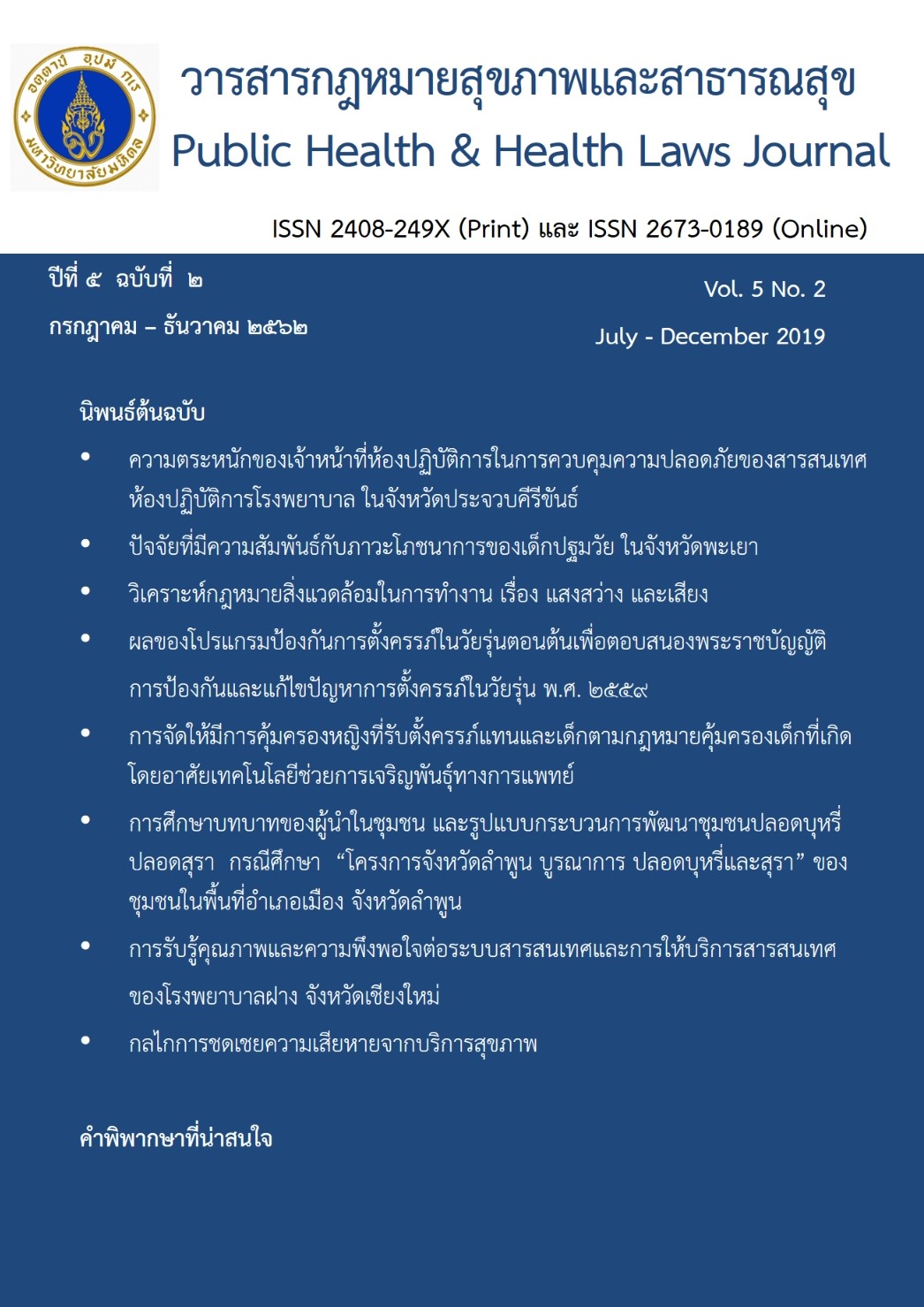The Role of Community Leaders and the Development Process for Smoke-free and Alcohol–free Community in Mueang Lamphun District, Lamphun Province : A Case Study of “The Lamphun Smoke-free and Alcohol–free Project”
Keywords:
The role of community leaders, Smoke–free community, Alcohol–free community, Community developmentAbstract
This study is an action research aimed to study the role of the community leader and to study the development process for smoke–free and alcohol–free under the context of community. The area of the study was the targeted community in Mueang Lamphun District, Lamphun Province within “The Lamphun Smoke–free and Alcohol–free Project in 2017”. Participants were 29 community leaders whom volunteered to participated in the research. The data of this research was collected by participating observation in the two-round planning and reflection. The data of the community environment were collected through the participated observation. Semi-structured interview was used for interviewing the community leaders and community members. The content analysis followed by the typological analysis were used to analyze the data within dimensions of the community developing for smoke–free and alcohol-free
The results found that (1) The perception of leader role among community leaders was influent by activities under the Lamphun Smoke–free and Alcohol-Free Project. According to the leaders’ considerations on the community structure, their role would lead to smoke–free and alcohol-free development plans that was applicable and could affect the community. (2) The development process of smoke–free and alcohol–free in community were as following. Firstly, the community team were created to monitor and control smoking and alcohol use. By concerning about the conflict of implement the law enforcement, the community leaders help to create the agreement that community member can accept. The new agreement which contain the essence of the law then were announced to everyone in the community. Secondly, alcohol free and smoke–free public areas were created. Thirdly, leaders’ houses were promoted and announced as smoke–free and alcohol free places. Fourthly, the community teams were formed for monitoring the convenient shops in order to ensure that the shops legally sell the cigarettes and alcohols. Fifth, activities for creating the awareness and persuading the community’s members were conducted.
From creating community agreement, it showed that at the community level, it had served to encourage people to follow the law. Therefore, if agencies at the district level enforces the law to support the community agreement, Smoking and alcohol control will be more complete.
References
จำนงค์ อดิวัฒนสิทธิ์ และคณะ.(2548). สังคมวิทยา. พิมพ์ครั้งที่ 12. กรุงเทพฯ : สำนักพิมพ์มหาวิทยาลัย เกษตรศาสตร์.
ธวัช บุณยมณี. (2550). ภาวะผู้นำและการเปลี่ยนแปลง. พิมพ์ครั้งที่ 1. กรุงเทพฯ : โอเดียนสโตร์.
“ประกาศสำนักนายกรัฐมนตรี ฉบับที่ 2 พ.ศ.2558 เรื่อง แต่งตั้งพนักงานเจ้าหน้าที่ เพื่อปฏิบัติตามพระราชบัญญัติควบคุมเครื่องดื่มแอลกอฮอล์ พ.ศ.2551”. ราชกิจจานุเบกษา 132 (21 ธันวาคม 2558), หน้า 11-12.
“ประกาศกระทรวงสาธารณสุข ฉบับที่ 19 พ.ศ.2553 ตามพระราชบัญญัติคุ้มครองผู้ไม่สูบบุหรี่ 2535”. ราชกิจจานุเบกษา 127 (30 มีนาคม 2553), หน้า 49-53.
เปรมฤดี ธงสิบสอง, อารมณ์ แสนเตชะ, ฉกรรจ์ แก้วโมลี, และ ทัศน์วันท์ แสนเตชะ. (2550). กระบวนการมีส่วนร่วมของประชาชชนในการเลิกบุหรี่ ตำบลเวียงต้า อำเภอลอง จังหวัดแพร่. รายงานการวิจัย ศูนย์วิจัยและการจัดการความรู้เพื่อการควบคุมยาสูบ.
“พระราชบัญญัติควบคุมผลิตภัณฑ์ยาสูบ พ.ศ.2535”. ราชกิจจานุเบกษา 109 (5 เมษายน 2535), หน้า 4-8.
“พระราชบัญญัติควบคุมเครื่องดื่มแอลกอฮอล์ พ.ศ.2551”. ราชกิจจานุเบกษา 125 (13 กุมภาพันธ์ 2551), หน้า 34-49.
พวงผกา สุริวรรณ. (2559). โครงการจังหวัดลำพูนบูรณาการปลอดบุหรี่และสุรา. แบบเสนอโครงการ สำนักงานสาธารณสุขจังหวัดลำพูน
มณฑา เก่งกาจพานิช, ธราดล เก่งกาจพานิช, ศรัณญา เบญจกุล, และกรกนก ลัธธนันท์. (2557). การดำเนินงานควบคุมบุหรี่(มวนเองหรือยาเส้น) โดยใช้ชุมชนเป็นฐาน. พิมพ์ครั้งที่ 1. กรุงเทพฯ : เจริญมั่นคงการพิมพ์.
วิเชียร จิตต์พิศาล, อภิรดี ขุมทอง, และ มน์ธิรา ไชยแขวง. (2551). การมีส่วนร่วมของชุมชนในการควบคุมการบริโภคยาสูบ บ้านท่าจูด หมู่ที่3 ตำบลบางนายสี อำเภอตะกั่วป่า จังหวัดพังงา. รายงานการวิจัย ศูนย์วิจัยและการจัดการความรู้เพื่อการควบคุมยาสูบ.
ศรัณญา เบญจกุล, หทัย ชนก พรรคเจริญ, และ Jason Hsia. (2559). อัตราการสูบบุหรี่ปัจจุบันของประชากรอายุตั้งแต่ 15 ปีขึ้นไป จำแนกรายจังหวัด. เอกสารประกอบการประชุมโครงการประเมินจังหวัดปลอดบุหรี่ ศูนย์พัฒนาศักยภาพกำลังคนด้าน การควบคุมยาสูบ (พศย.).
ศิริวรรณ พิทยรังสฤษฏ์, ปานทิพย์ โชติเบญจมาภรณ์ และปวีณา ปั้นกระจ่าง. (2559). สถานการณ์การควบคุมการบริโภคยาสูบของประเทศไทย พ.ศ.2559. พิมพ์ครั้งที่ 1. กรุงเทพฯ : เจริญดีมั่นคงการพิมพ์.
ศูนย์วิจัยและจัดการความรู้เพื่อการควบคุมยาสูบ. (1 กันยายน 2558). “คำถามการวิจัยด้านการควบคุมยาสูบ ของศูนย์วิจัยและจัดการความรู้เพื่อการควบคุมยาสูบ (ศจย.) พ.ศ.2558-2561”.
สำนักงานพัฒนานโยบายสุขภาพระหว่างประเทศ. (2556). รายงานสถานการณ์การบริโภคเครื่องดื่มแอลกอฮอล์รายจังหวัด พ.ศ.2554. พิมพ์ครั้งที่ 1. นนทบุรี : เดอะ กราฟิโก ซิสเต็มส์ จำกัด.
World Health Organization. Health promotion : The Ottawa Charter for Health Promotion. (Online), Retrieved February 7,2019. form : https://www.who.int/healthpromotion/conferences
/previous/ottawa/en/.
Downloads
Published
How to Cite
Issue
Section
License
Disclaimer and Copyright Notice
The content and information presented in articles published in the Journal of Law and Public Health Policy represent the opinions and sole responsibility of the respective authors. The editorial board does not necessarily agree with or assume any responsibility for the views expressed.
All articles, data, content, images, and other materials published in the Journal of Law and Public Health Policy are the intellectual property of the journal. Any individual or organization wishing to reproduce, distribute, or otherwise use the entirety or any part of such materials must provide proper citation.





